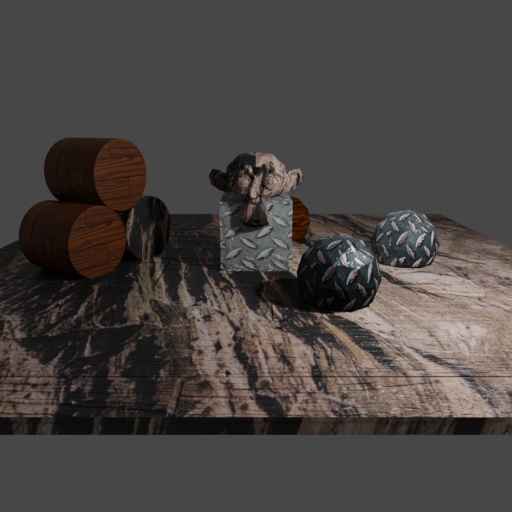Material selection and manipulation

In this example we demonstrate how to select materials in the scene using getter.Material and then manipulate them using the MaterialManipulator module.
Usage
Execute this in the BlenderProc main directory:
blenderproc run examples/basics/material_manipulation/main.py examples/basics/material_manipulation/scene.obj images examples/basics/material_manipulation/output
examples/basics/material_manipulation/main.py: path to the python file.examples/basics/material_manipulation/scene.obj: path to the object file with the basic scene.images: path to a folder with .jpg textures to be used in the sampling process.examples/basics/material_manipulation/output: path to the output directory.
Visualization
Visualize the generated data:
blenderproc vis hdf5 examples/basics/material_manipulation/output/0.hdf5
Steps
Material manipulation
# Find all materials
materials = bproc.material.collect_all()
# Find the material of the ground object
ground_material = bproc.filter.one_by_attr(materials, "name", "Material.001")
# Set its displacement based on its base color texture
ground_material.set_displacement_from_principled_shader_value("Base Color", multiply_factor=1.5)
The focus of this example is the selection and adaption of a material.
With the
filter.one_by_attrwe filter again for a certain material, for that we use all materials currently available.
All available material attribute name‘s can be seen here: https://docs.blender.org/api/current/bpy.types.Material.html
We then link the input to the Base Color of the principled shader to the displacement output of the material and multiply with a given factor before that.
This value is used to scale the color input the texture up or down to increase or decrease the effect of the displacement.

# Collect all jpg images in the specified directory
images = list(Path(args.image_dir).rglob("material_manipulation_sample_texture*.jpg"))
for mat in materials:
# Load one random image
image = bpy.data.images.load(filepath=str(random.choice(images)))
# Set it as base color of the current material
mat.set_principled_shader_value("Base Color", image)
Finally, for all materials including the ground material a new image is loaded and selected as the Base Color input.
This means that the image which has been used for the displacement is now only used for the displacement and a new image is used for the color information.
This is the visible in the preview image at the top, that the displacement does not align with the texture of the object.